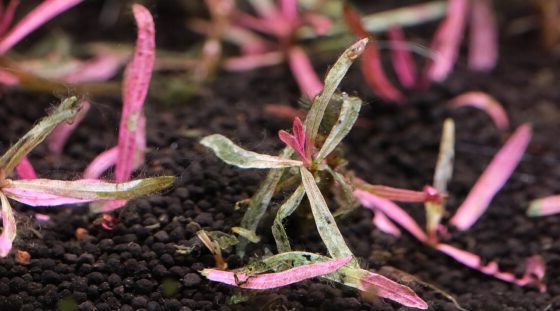Is your aquarium plants melting? Don’t worry, we’ve got you covered! Aquarium plants are not only an aesthetic addition to your fish tank, but they also contribute to the overall health of your aquatic ecosystem. So, it can be disheartening to see them deteriorate.
In this article, we will explore the reasons behind why your aquarium plants might be melting and provide you with practical solutions to revive their lush green appearance. So, let’s dive right into the mystery of why are my aquarium plants melting and how to fix it!
Why Are My Aquarium Plants Melting?
Aquarium plants are not only aesthetically pleasing but also play a crucial role in maintaining a balanced and healthy aquatic ecosystem for your fish. However, it can be disheartening to see your precious plants melting away, turning brown, and deteriorating.
This phenomenon is commonly known as plant melting, and it’s essential to understand why it occurs and how to prevent it. In this article, we will delve into the various factors that contribute to plant melting and provide useful tips to help you maintain thriving aquarium plants.
Poor Water Conditions
Maintaining optimal water conditions is vital for the health and well-being of your aquarium plants. When water parameters deviate from the ideal range, plants may experience stress, leading to melting. Here are some common water condition issues that can cause plant melting:
Inadequate Lighting
Proper lighting is essential for photosynthesis, the process by which plants convert light into energy. If your aquarium plants do not receive enough light, they may not be able to produce sufficient energy, leading to plant melting.
On the other hand, excessive lighting can also cause melting due to light burn. It’s crucial to research the lighting requirements of your specific plant species and provide them with the appropriate intensity and duration of light.
Imbalanced Nutrients
Just like any other living organism, aquarium plants require a balanced diet of nutrients to thrive. Insufficient or excessive nutrients can result in plant melting. The three primary nutrients needed by plants are nitrogen (N), phosphorus (P), and potassium (K), commonly known as NPK. A deficiency in any of these nutrients can cause plant stress and melting.
Additionally, other essential micronutrients, such as iron and magnesium, play crucial roles in plant health. Regularly testing water parameters and supplementing nutrients as necessary can help prevent nutrient imbalances and subsequent plant melting.
Fluctuating Water Temperature
Sudden or drastic fluctuations in water temperature can cause stress to aquarium plants, leading to melting. It’s important to maintain a stable water temperature within the appropriate range for your plants and ensure gradual changes when adjustments are necessary.
Sudden temperature shifts can be particularly harmful during water changes or when introducing new fish to the tank. Using a reliable heater and monitoring the water temperature consistently can help prevent temperature-related plant melting.
Improper Water Chemistry
Maintaining the correct water chemistry is crucial for the overall health of your aquarium plants. Factors such as pH, water hardness, and dissolved oxygen levels can significantly impact plant growth and vitality.
Certain plant species have specific preferences for water chemistry parameters, and deviating from their preferred range can lead to plant stress and melting. Regularly testing and adjusting water chemistry parameters based on the needs of your plants can help prevent plant melting.
Read More: About Mushrooms Growing In Strawberry Plant: A Fascinating Phenomenon
Poor Plant Care
In addition to water conditions, the way you care for your aquarium plants can also influence their health and susceptibility to melting.
Here are some common plant care mistakes that may contribute to plant melting:
Improper Plant Placement
Each plant species has unique light and nutrient requirements, as well as growth habits. Placing plants in inappropriate locations within your aquarium can hinder their growth and make them more susceptible to melting. Some plants require direct light, while others thrive in shaded areas.
Researching the specific needs of your plants and arranging them accordingly can help optimize their growth and minimize the risk of melting.
Overcrowding
Overcrowding your aquarium with too many plants can result in limited access to light and nutrients, leading to plant stress and melting. It is essential to consider the growth habits and space requirements of each plant species and provide adequate room for them to flourish.
Regular pruning and thinning of plants can help prevent overcrowding and promote healthier growth.
Poor Substrate Choice
The substrate in your aquarium plays a vital role in anchoring plant roots and providing access to essential nutrients. Choosing the right substrate for your plants is crucial. Some plants may require a nutrient-rich substrate, while others thrive in gravel or sand.
Conduct research on the substrate requirements of your specific plant species and ensure they are planted in the appropriate substrate to prevent nutrient deficiencies and melting.
Insufficient CO2 Levels
Carbon dioxide (CO2) is an essential element for photosynthesis, and inadequate levels can impede plant growth and lead to melting. While some plants can utilize atmospheric CO2, others may benefit from supplemental CO2 injection.
Monitoring CO2 levels and providing supplementation when necessary can help promote healthy plant growth and prevent melting.
Preventing Aquarium Plant Melting
Now that we have explored the potential causes of plant melting, let’s discuss some preventive measures you can implement to ensure your aquarium plants thrive:
Research Plant Species
Before adding any plants to your aquarium, conduct thorough research on the specific needs and requirements of each plant species.
Take into consideration their lighting, nutrient, and water chemistry preferences to provide them with the best possible environment.
Provide Proper Lighting
Ensure your aquarium plants receive the appropriate amount and quality of light. Invest in a reliable aquarium light that meets the needs of your plants and consider using timers to maintain consistent lighting schedules.
Balance Nutrient Levels
Regularly test water parameters and supplement nutrients as needed. Consider using liquid or substrate fertilizers to provide essential macronutrients and micronutrients for healthy plant growth.
Remember to follow the instructions provided by the manufacturer and avoid over-fertilization, which can also be detrimental to plant health.
Maintain Stable Water Conditions
Monitor and maintain stable water temperature, pH, water hardness, and dissolved oxygen levels within the optimal range for your plants. Avoid sudden changes in water conditions and acclimate new plants gradually to prevent stress and melting.
Proper Pruning and Maintenance
Regularly prune and thin out your aquarium plants to prevent overcrowding and promote healthy growth. Remove any decaying or melted plant parts promptly to prevent the spread of diseases or nutrient imbalances.
Consider CO2 Supplementation
Monitor CO2 levels in your aquarium and provide supplemental CO2 if necessary. This is particularly beneficial for plants with higher CO2 requirements and can promote robust growth and prevent melting.
Observe and Adjust
Regularly observe your aquarium plants for any signs of stress or melting. If you notice any issues, take immediate action to identify and rectify the underlying cause. Making small adjustments to lighting, nutrient supplementation, or water chemistry can often help restore plant health and prevent further melting.
By understanding the potential causes of aquarium plant melting and implementing proactive measures, you can enjoy a vibrant and thriving aquatic plant environment in your aquarium.
Remember to provide optimal water conditions, conduct thorough plant care practices, and make necessary adjustments based on the specific needs of your plant species. With proper care and attention, you can maintain healthy and beautiful aquarium plants for years to come.
Read More: About Dirt Locker Alternative: A Game-Changing Solution For Storage
Frequently Asked Questions (FAQs)
Poor water quality, particularly high ammonia or nitrate levels, can stress aquarium plants and cause them to melt. It is important to regularly test the water parameters and ensure they are within the appropriate range for plant health.
Yes, inadequate lighting can cause plants to melt. Aquarium plants require sufficient light for photosynthesis, and without it, they may not be able to thrive and can start melting. Make sure to provide the appropriate lighting intensity and duration for your plants.
Improper fertilization, either excessive or insufficient, can contribute to plant melting. Plants need a balanced supply of essential nutrients, such as nitrogen, phosphorus, and potassium. Monitoring and providing the right amount of fertilizers can help prevent nutrient deficiencies or toxicities.
Yes, newly introduced plants may experience melting as they adjust to their new environment. This is often temporary and can be a result of changes in water parameters, lighting, or transportation stress. Providing proper care and maintaining stable conditions can help them recover.
CO2 deficiency can hinder plant growth and lead to melting. Carbon dioxide is an essential component for photosynthesis, and without enough of it, plants may struggle to produce energy and nutrients. Ensuring adequate CO2 levels through injection or supplementation can prevent melting.
Insufficient water circulation can lead to stagnant areas where organic matter accumulates, negatively affecting plant health. Proper water circulation helps distribute nutrients and oxygen, preventing plant decay and melting. Consider using a suitable filter or water pump to improve circulation.
Some fish and invertebrates, particularly herbivorous species, may feed on aquarium plants, causing damage and contributing to melting. It is important to choose compatible tank mates and provide alternative food sources to prevent excessive plant consumption.
Extreme temperature changes, such as rapid heating or cooling, can stress aquarium plants and lead to melting. It is crucial to maintain a stable temperature within the recommended range for your specific plants. Using a heater and avoiding direct sunlight can help prevent temperature fluctuations.
Final Thoughts
Aquarium plants can melt due to various reasons. One common cause is a sudden change in water conditions such as temperature, pH level, or lighting. This shock can cause the plants to shed their leaves as a defense mechanism. Another reason could be inadequate nutrients in the water or poor water quality. It’s important to ensure a balanced and suitable environment for your aquatic plants to thrive.
Regular monitoring of water parameters, providing proper lighting and nutrition, and maintaining good water quality can help prevent the melting of your aquarium plants. So, if you’re wondering, “why are my aquarium plants melting,” consider these factors and take appropriate action to restore the health of your plants.
Auto Amazon Links: No products found.
Perfect Plants Christmas Tree Saver 8oz. | Easy Use Xmas Tree Preserver Food | Have Healthy Green Christmas Trees All Holiday Season
$9.97 (as of December 11, 2025 04:08 GMT +00:00 - More info- Product prices and availability are accurate as of the date/time indicated and are subject to change. Any price and availability information displayed on [relevant Amazon Site(s), as applicable] at the time of purchase will apply to the purchase of this product.
Rocky Mountain Goods Christmas Tree Food - 8 oz Tree Preservative - Reduce Needle Drop - Greener Scent - Fir, Pine, Spruce Trees - Extend Tree Life
$9.95 (as of December 11, 2025 04:08 GMT +00:00 - More info- Product prices and availability are accurate as of the date/time indicated and are subject to change. Any price and availability information displayed on [relevant Amazon Site(s), as applicable] at the time of purchase will apply to the purchase of this product.
VICAMB 39.3 Inch Christmas Tree Watering Funnel,Christmas Tree Watering System Device,Long Tree Watering Funnel Spout for Indoor Outdoor Xmas Tree
$16.99 (as of December 11, 2025 04:08 GMT +00:00 - More info- Product prices and availability are accurate as of the date/time indicated and are subject to change. Any price and availability information displayed on [relevant Amazon Site(s), as applicable] at the time of purchase will apply to the purchase of this product.
SUNEZLGO Christmas Tree Watering Funnel, Christmas Tree Watering System Tree Waterer, Real Christmas Tree Water Funnel, Xmas Adjustable Metal Tubes Spout for Indoor Outdoor Christmas Tree
$19.99 (as of December 11, 2025 04:08 GMT +00:00 - More info- Product prices and availability are accurate as of the date/time indicated and are subject to change. Any price and availability information displayed on [relevant Amazon Site(s), as applicable] at the time of purchase will apply to the purchase of this product.
EZMeetU Christmas Tree Watering Funnel, 47 Inch Flower Shape Adjustable 6 Section Design, Christmas Tree Watering System, Christmas Tree Waterer, Long Funnel Wide Opening Reusable, Plant Watering Tool
$16.99 (as of December 11, 2025 04:08 GMT +00:00 - More info- Product prices and availability are accurate as of the date/time indicated and are subject to change. Any price and availability information displayed on [relevant Amazon Site(s), as applicable] at the time of purchase will apply to the purchase of this product.
Muddy Mat® Shown on TV Super Absorbent Microfiber Dog Door Mat for Muddy Paws, Non-Slip Washable Pet Rug, Quick Dry Chenille Entryway Carpet, Machine Washable Indoor Outdoor mat, Grey 30"x19"
$24.95 (as of December 9, 2025 17:49 GMT +00:00 - More info- Product prices and availability are accurate as of the date/time indicated and are subject to change. Any price and availability information displayed on [relevant Amazon Site(s), as applicable] at the time of purchase will apply to the purchase of this product.
Snow Joe Premium Enviro Blend Ice Melt, Green-Coated Deicer Crystals, 50 lb - Safer Melter for Vegetation, Concrete & Metals w/ Anti-Corrosion Calcium Magnesium Acetate
$32.97 (as of December 9, 2025 17:49 GMT +00:00 - More info- Product prices and availability are accurate as of the date/time indicated and are subject to change. Any price and availability information displayed on [relevant Amazon Site(s), as applicable] at the time of purchase will apply to the purchase of this product.
Zevo Flying Insect Trap Official Refill Cartridges - Fits Both Zevo Trap & MAX Indoor Fly Trap - Authentic Trap+Lock Technology to Catch Gnats, House & Fruit Flys (4 Official Refill Cartridges)
$11.01 (as of December 9, 2025 17:49 GMT +00:00 - More info- Product prices and availability are accurate as of the date/time indicated and are subject to change. Any price and availability information displayed on [relevant Amazon Site(s), as applicable] at the time of purchase will apply to the purchase of this product.
OLANLY Dog Door Mat for Muddy Paws 30x20, Absorbs Moisture and Dirt, Absorbent Non-Slip Washable Doormat, Quick Dry Chenille Mud Mat for Dogs, Entry Indoor Entryway Carpet for Inside Floor, Grey
$9.99 (as of December 9, 2025 17:49 GMT +00:00 - More info- Product prices and availability are accurate as of the date/time indicated and are subject to change. Any price and availability information displayed on [relevant Amazon Site(s), as applicable] at the time of purchase will apply to the purchase of this product.
ivtivfu Rolling Grill Basket, Removable Wooden Handle, 304 Stainless Steel, Nesting BBQ Tools, Smoker Grilling Accessories for Vegetable, Outdoor Cooking Camping, Birthday Gifts for Men Dad Husband
$24.99 (as of December 9, 2025 17:49 GMT +00:00 - More info- Product prices and availability are accurate as of the date/time indicated and are subject to change. Any price and availability information displayed on [relevant Amazon Site(s), as applicable] at the time of purchase will apply to the purchase of this product.











